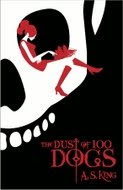 Whitcomb, Laura. A Certain Slant of Light. Boston: Graphia-Houghton Mifflin Company, 2005.
Whitcomb, Laura. A Certain Slant of Light. Boston: Graphia-Houghton Mifflin Company, 2005.[Book cover credit: librarything.com/work/73919]
Awards:
ALA Best Books for Young Adults (2006)
ALA Popular Paperbacks for Young Adults (Death and Dying, 2009)
Booktalk:
Helen has been "haunting" writers for 130yrs. By haunting, I mean acting as their unnoticed muse. She's grown used to existing on the sidelines of the lives of her writers. She has a happy afterlife. Her current writer, Mr. Brown, teaches English during the day. It's in his class that everything changes. A student looks at her, hears her, knows that she's there. And now that Helen has someone to interact with rather than thanklessly inspire, she can't let him go. Even if she has to "borrow" a human body, like he has, to keep him.
Review:
I've been eyeing this book since it came out 4 years ago, but I'm not a big fan of ghost stories (read: I'm a big wimp when it comes to scary stuff with no explanations). I put off reading it. Happily for me, this book is not scary. At all. There are some suspenseful moments, but they have nothing to do with ghosts so much as crazy parenting. But I'll get to that in a minute.
Basically, James, who used to haunt the park, found an empty body. The soul had walked off when the body OD-ed, so James decided to hop in. Because he's still a ghost, he can see Helen. They've both been alone for decades and relish in each other's company. They fall in love. Unfortunately, all of these inconvenient physical urges come with James' borrowed body. He wants to satisfy them with Helen, but to do that she also needs a body. They find her an empty body at, where else, the mall. Now James, in Billy's body, and Helen, in Jenny's body, are free to go at it like rabbits.
There are of course, complications such as when Billy's brother, who is raising Billy while their mom is in a coma and their dad is in jail, catches James and Helen (Billy and Jenny?) in the act. Or when Jenny's mom, who is ruled by her EXTREMELY religious husband, finds bloody panties when it's not Jenny (Helen?)'s time of the month and assumes, correctly, that someone has popped Jenny's cherry. Or when Helen starts to get nauseous every time she smells food after having lots of condoms-weren't-invented-before-I-died sex. But these are small roadblocks in Helen and James' love story.
This is paranormal romance at its best. Everyday concerns are left by the wayside as the extraordinary circumstances that make this love story work take precedence. As long as that's what you're looking for, you'll love this. But if you want a good almost Halloween ghost story, look elsewhere.
Book source: Philly Free Library





